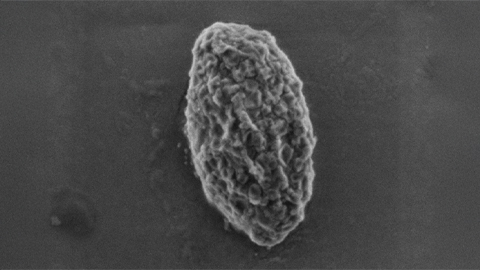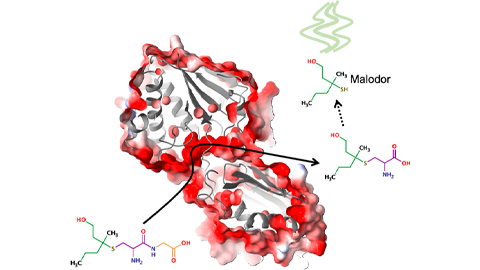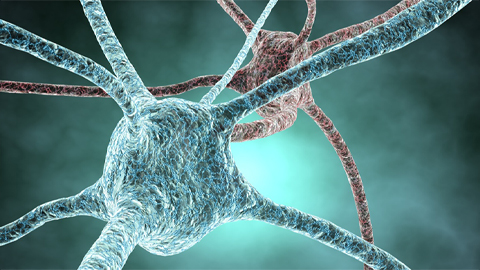Huntingtin through a multiomic lens
Tracing the effects of a single gene’s mutation can be hard. Huntington’s disease, for example, is caused by just one mutation — but that change reverberates throughout the brain. Research published in the journal Molecular & Cellular Proteomics shows that the mutant protein that causes Huntington’s can alter the binding properties of another protein, perhaps accounting for some of the mutation’s far-flung cellular effects.

Huntington’s disease, an as-yet-untreatable neurodegenerative disorder, is caused by a mutation that affects the protein huntingtin. Huntingtin is large to begin with; in patients, a repeat region in the gene adds an expanding tract of glutamine residues to the protein, making it sticky and prone to aggregate. But how the protein change leads to profound problems in neurons is up for debate.
“Very few proteins act as a monolithic structure,” said Joel Federspiel, a postdoctoral fellow in Ileana Cristea’s lab at Princeton University. Instead, most act in coordination with other proteins. The same is probably true for huntingtin — but previous interactomics studies turned up thousands of binding partners. Which ones are important for the way the disease develops?
Recent research had shown that reducing neuronal levels of the protein HDAC4, which binds to mutated huntingtin, may reduce Huntington’s symptoms, at least in mice. Oddly, however, blocking the enzymatic activity of HDAC4, which belongs to a class of enzymes that alter histone proteins that organize DNA, did not have the same effect.
To Federspiel and Cristea, the data suggested that HDAC4 was contributing to the onset of disease through a binding interaction either with huntingtin or with other proteins. So they hopped one ripple ring away from huntingtin protein itself to study how HDAC4 changes in a brain affected by the disease.
The researchers used immunoaffinity purification followed by mass spectrometry to catalogue all of the proteins that interact with HDAC4 in the mouse brain. In a mouse model of Huntington’s, they found major changes to the HDAC4 interactome around the age at which symptoms start to appear.
“You can, in a case like this, have hundreds to thousands of proteins or transcripts that are differentially regulated,” Federspiel said. “Trying to home in on just a few of those to focus on can be challenging. However, if you have more lines of evidence, then you start to see what things are common.”
To find the significant proteins, they layered in additional data from earlier transcriptome and proteome studies. After they applied what they called a lens of multiomics, a few insights came into focus.
In the mice with huntingtin mutations that were old enough to exhibit symptoms, HDAC4 associated with many huntingtin-binding proteins — more so than in the brains of healthy mice or younger mutants.
Many of the interacting proteins were involved in the organization of synapses and vesicle transport. In the mutant mice, those proteins interact with HDAC4 much more strongly. The effect was most noticeable in cells in the striatum, a brain region that controls movement and is affected greatly in Huntington’s disease.
That’s good circumstantial evidence that, in Huntington’s-affected brains, a changing HDAC4 interactome may contribute to symptoms. Exactly how, the researchers say, remains to be determined.
Enjoy reading ASBMB Today?
Become a member to receive the print edition four times a year and the digital edition monthly.
Learn moreGet the latest from ASBMB Today
Enter your email address, and we’ll send you a weekly email with recent articles, interviews and more.
Latest in Science
Science highlights or most popular articles

Using 'nature’s mistakes' as a window into Lafora disease
After years of heartbreak, Lafora disease families are fueling glycogen storage research breakthroughs, helping develop therapies that may treat not only Lafora but other related neurological disorders.

Cracking cancer’s code through functional connections
A machine learning–derived protein cofunction network is transforming how scientists understand and uncover relationships between proteins in cancer.

Gaze into the proteomics crystal ball
The 15th International Symposium on Proteomics in the Life Sciences symposium will be held August 17–21 in Cambridge, Massachusetts.

Bacterial enzyme catalyzes body odor compound formation
Researchers identify a skin-resident Staphylococcus hominis dipeptidase involved in creating sulfur-containing secretions. Read more about this recent Journal of Biological Chemistry paper.

Neurobiology of stress and substance use
MOSAIC scholar and proud Latino, Bryan Cruz of Scripps Research Institute studies the neurochemical origins of PTSD-related alcohol use using a multidisciplinary approach.

Pesticide disrupts neuronal potentiation
New research reveals how deltamethrin may disrupt brain development by altering the protein cargo of brain-derived extracellular vesicles. Read more about this recent Molecular & Cellular Proteomics article.

